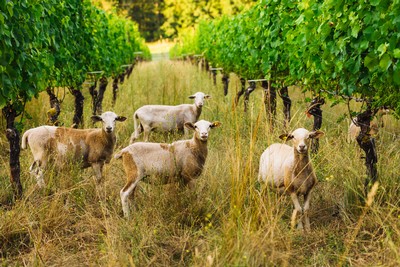Grazing-Based Viticulture
Katahdin/Dorper Sheep
 Our Katahdin/Dorper crossbred sheep are the cornerstone of Grazing-Based Viticulture. For the last 20 years, we have been working to cross these breeds to capture the exceptional lamb quality, hardiness, mothering instincts, and lamb vigor of the Katahdin with the shorter stature and meatier frame of Dorper. We are slowly building our own line of genetics that physically suit the vineyard while also being low-maintenance and capable of producing exceptional lamb on a pure grass diet.
Our Katahdin/Dorper crossbred sheep are the cornerstone of Grazing-Based Viticulture. For the last 20 years, we have been working to cross these breeds to capture the exceptional lamb quality, hardiness, mothering instincts, and lamb vigor of the Katahdin with the shorter stature and meatier frame of Dorper. We are slowly building our own line of genetics that physically suit the vineyard while also being low-maintenance and capable of producing exceptional lamb on a pure grass diet.
Ovines rely on a rich population of digestive microfauna in their four stomachs to break down cellulose-rich diets. Each stomach has specific fermentation cultures for different forages in different stages of digestion – in short, each sheep is like a mobile micro-brewery. Collectively, they consume many tons of atmospherically captured carbon in the form of vineyard floor forage, which is then converted into microbially inoculated and nutrient-rich feed for the vineyard. These digestive inoculants, combined with cycles of root growth and die-off, have led to a singular evolutionary arc in the microbiome of our soils, yielding startling results.
The peak of the lambing season will see our flock swell to around 100 sheep. We time our lambing season to make optimal use of the lush, new grass growth that comes in April, May, and early June. Lambs are born in February and are weaned by late April. Changing populations to accommodate shifts in resources allows the farm to breathe with the seasons and is one of the most important functions of managing a self-sustaining grazing system. While integrating livestock into a vineyard system is extremely labor intensive, we believe it is a critical component in the creation of a vineyard that clearly and authentically expresses an articulate and unique voice.
Join Our Mailing List
Keep up to date on the latest wine releases and happenings at the Farm.